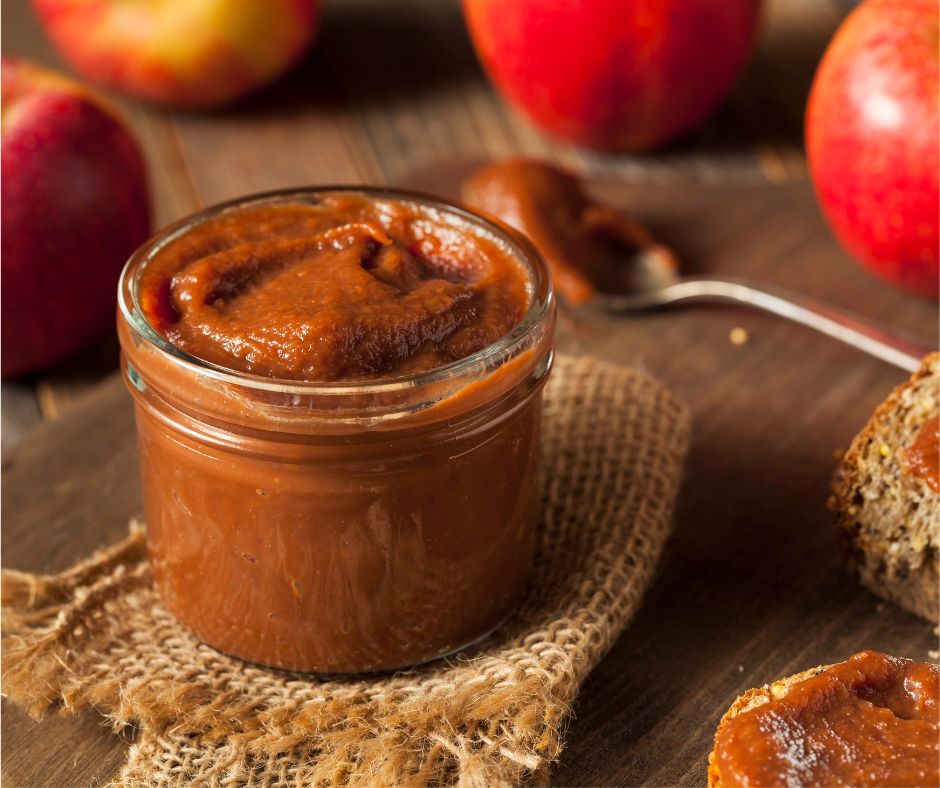Butter me up! Fall is a great time for fruit butters

Ah, fall, my favorite season, the season of apples, pumpkins and more. The first images that come to mind might be caramel apples and jack-o-lanterns. Or maybe it is apple or pumpkin pie. But few people think about fruit butters.
Fruit butters are a bit like jams and jellies, but with way less guilt. I know many of us realize as we get older that our parents and grandparents were right about so many things. Like composting. Generations of people composted before it was the cool thing to do. Well, actually composting is a hot process … but I digress.
The Greatest Generation wasted nothing. And a great way to use up those overflowing bushels of apples, or a quarter field of pie-pumpkins, was to make fruit butters. Most people see them as a novelty at farmers markets or in Amish country. But these low-sugar, packed-with-flavor spreads, are not only delicious but one of the easiest products to put up.
“Put up” is an old-fashioned term for preserving. As in the case of most fruit butters that means canning But with pumpkin butter, freezing is the only food-safe option, according to Mary Liz Wright, University of Illinois Extension Educator in Food and Wellness serving Clark, Crawford, and Edgar counties. She is my expert any time I have a tough question about food preservation.
She also offered these hints: Do not peel the fruits before cooking; you will have more flavor and better texture if you leave the peel on (it does not come through the sieve (strainer), so it is not in the final product).
Never reduce the amount of sugar in a recipe. Sugar binds with the liquids in fruit butters. And many people don’t realize it, but sugar is a preservative (No wonder I have lasted this long—heck, with the amount of sugar I eat, I may be here for a long time).
But seriously, always remember, canning, similar to baking — they are both food science. The proportions matter. That is why it is important to use current recipes from the National Center on Home Preservation. Here is a link to the nationally approved, most current website on canning fruit (with some great recipes): https://nchfp.uga.edu/how/can2_fruit.html#gsc.tab=0.
We didn’t know as much about food safety back in the day. Science improves our lives every day, whether it is a new disease-resistant hybrid our farmers are planting, a newly discovered medicine, or a better understanding of what potential harm inadequate food preservation can cause.
Not to worry, canning is just following instructions. Here is a great recipe for apple butter from that website.
Apple Butter: Use Jonathan, Winesap, Stayman, Golden Delicious, Macintosh, or other tasty apple varieties for good results.
- 8 lbs. apples
- 2 cups apple cider
- 2 cups vinegar
- 2¼ cups white sugar
- 2¼ cups packed brown sugar
- 2 tbsp ground cinnamon
- 1 tbsp ground cloves
Yield: About 8 to 9 pints
Wash, remove stems, quarter, and core fruit. Cook slowly in cider and vinegar until soft. Press fruit through a colander, food mill, or strainer. Cook fruit pulp with sugar and spices, stirring frequently. To test for doneness, remove a spoonful and hold it away from steam for 2 minutes. It is done if the butter remains mounded on the spoon. Another way to determine when the butter is cooked adequately is to spoon a small quantity onto a plate. When a rim of liquid does not separate around the edge of the butter, it is ready for canning. Fill hot into sterile half-pint or pint jars, leaving ¼-inch headspace. Quart jars need not be presterilized. In a boiling-water bath canner, process the apple butter as follows:
Half-pints or pints, 5 minutes. For quarts, 10 minutes. (This is for our altitude range 0-1,000 ft. Processing times for areas in other altitudes vary refer to the National Home Preservation website above for those details.) This recipe was adapted from the “Complete Guide to Home Canning,” Agriculture Information Bulletin No. 539, USDA, revised 2015. Reviewed February 2018.
You can also combine various fruits to make a combination fruit butter. From Penn State University, this recipe for pear butter as the bright citrus of orange.

Pear Butter
Pear Butter
- 2 quarts pear pulp (about 20 medium, fully ripe pears)
- 4 cups sugar
- 1 teaspoon grated orange rind
- ⅓ cup orange juice
- ½ teaspoon ground nutmeg
Cut pears in quarters and remove cores. Cook until soft, adding only enough water to prevent sticking (about ½ cup.) Press through a sieve or food mill. Measure pulp.
Add remaining ingredients and cook until thick, about 15 minutes. As mixture thickens, stir frequently to prevent sticking. (Refer to doneness tests described above). Pour hot butter into hot sterilized jars, leaving ¼ inch headspace. Wipe jar rims and adjust lids. Process 5 minutes in a boiling water bath or atmospheric steam canner. (Adjust process times for high altitudes).
Remove canner from heat and remove canner lid. Wait five minutes before removing jars. Makes about 4 half-pint jars. Recipe from “So Easy to Preserve, 6th Edition.”
You can use any fruit butter you would a jam, jelly or preserve, but there are some other options. Replace some of the fat in recipes by adding fruit butter; use fruit butter between cake layers instead of frosting; make sandwich cookies with fruit butter as the crème filling.
